Back to Features Page
Art Daniels takes a look at what tools and accessories can help make the difference between getting home for dinner or spending all night on the trail fixing your rig. |
|
| BE PREPARED!
This article is structured in five parts: Tools, Parts, Miscellaneous Stuff, Fluids, and Extrication Gear. Each part will be further broken down into three subparts: Basic Equipment, Well Equipped, and Rolling Service Station. The subparts are an arbitrary categorization to illustrate that this isn't an all-or-nothing thing. Feel free to pick and choose from all subparts to customize your Git Back Box to fit your needs and budget. TOOLS
To be Well Equipped, add a 1/4" socket set, change the open end wrenches to open/box end wrenches up to 1 1/4", an extra 9/16" wrench, metric wrenches 6-24mm, add deep sockets, axle hub bit, Allen wrenches, Torx wrenches, pliers, needle nose pliers, diagonal cutters, wire crimper, propane torch, butane solder iron, utility knife, hammer-struck impact wrench, hammer, 24" length of 1 1/4" pipe for a breaker bar, T style lug wrench, and jumper cables. A Rolling Service Station would carry all of the above plus a part retriever tool (telescoping magnetic or grabber), 12pt. 1/4" socket for carrier cross-shafts, cordless drill, pop rivet tool, gear puller, air tools, impact sockets, battery carrying strap, battery terminal cleaning tool, and a welder. PARTS You could carry an entire spare truck, but for most of us that's impractical. The best way to figure out what spares you need is to see what breaks on your truck or similar rigs and carry spares. However, there are some items most of us should carry as Basic Equipment: hoses, several sizes of hose clamps, a length of vacuum line, some brake line, fuses, belts, oil filter, and a fuel filter.
There are also emergency fan belts which will serve to get you back to civilization. Well Equipped four-wheelers will carry the above plus a hunk of fuel line, axle and driveshaft U joints, a spare headlight, spark plugs, distributor cap, rotor, coil, tire valve stems with cores, radiator cap, and a starter relay. If you run ARB lockers, you might also carry extra air lines, o-rings, air line couplers, and bulkhead parts. Rolling Service Stations will carry all of the above plus axle shafts, ball joints, drive shafts, a spare alternator, starter, an electric fuel pump, both pressure and return power steering hoses, oil pressure and water temperature sensor sending units, and a thermostat. Old parts can be a source of spares. Next time you do a tune-up keep the old plugs and distributor cap as spares. Also remember that you can limp home without items such as thermostats in a pinch. MISCELLANEOUS STUFF Under this category you could carry almost anything! You really ought to have duct tape, wire ties, flashlight, bungee cords, WD40, brake/parts cleaner, carburetor cleaner, some rags, and RTV silicone as a minimum.
Tarp? Turkey baster? Lay the tarp on the ground to keep yourself out of the mud and to catch small parts. The turkey baster can be used to move a variety of fluid, especially gear lube. The pail can catch fluid you need to drain, fetch water, and store gear. Remember, Tread Lightly! If you do spill fluids on the trail, either absorb it with dirt and pack it out or at least bury it. Soap, waterless handcleaner, and paper towels come in handy for the eventual clean-up. I'm not a doctor, and I don't even play one on TV. So I'm not going to tell you what to carry in a first aid kit. I will tell you that you should have one, however! Also, in many parts of the country, carry a snake-bite kit. FLUIDS In addition to your favorite softdrinks (leave the booze in camp!), bring plenty of water. Your battery may need water, your radiator may need a drink, it works in the washer fluid reservoir, it's useful for clean-up, and it's good to drink. Bring at least a gallon.
Bring enough gear lube to change one differential. (usually 2.5 - 3 quarts). Don't forget limited slip additive if your differentials need it. If your rig is an automatic bring along a quart of ATF. Round things out with power steering fluid and brake fluid. Did I mention you should bring water? Bring some more. Two gallons is a good amount unless you're heading into the desert, in which case you'll need more! EXTRICATION GEAR
If you don't have tow hooks or other attachment places front and rear, get them! Be aware that trailer hitch balls are not tow strap attachment points. They weren't made to handle the sudden, violent tugs; the ball will break off and become a deadly missile. Remove the ball and insert a clevis if you want to use the hitch as a tow point. The Well Equipped four-wheeler also has a winch, snatch block, thick towel or small rug, and anchor. Use the towel to lay over the cable to trap the cable should it break. A snapped cable can tear a human body in half; it's best to let it spend the energy on a towel. SUMMARY
Plan ahead, gear up, and be prepared! |
|
|
Help spread the ROCKCRAWLER world!
Share on Facebook
|
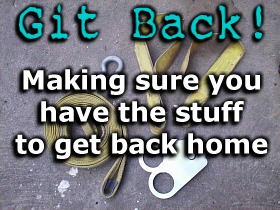
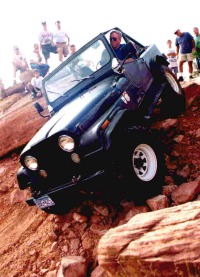 Remember
the Boy Scout motto, "Be Prepared?" When you're out on
the trail and something breaks you'll be glad you did! I'm always
surprised when I'm 'wheeling and come across a busted truck and
the owner doesn't have basic tools and parts along to fix it. Having
them can mean the difference between walking out and driving out.
Remember
the Boy Scout motto, "Be Prepared?" When you're out on
the trail and something breaks you'll be glad you did! I'm always
surprised when I'm 'wheeling and come across a busted truck and
the owner doesn't have basic tools and parts along to fix it. Having
them can mean the difference between walking out and driving out.
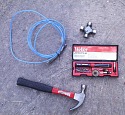 Let's
begin with tools. When something breaks you're going to need them
to disassemble, repair/replace, and reassemble. Basic Equipment
should include a set of open end wrenches 1/4" through 3/4",
metric wrenches 8-17mm, 3/8" socket set, multi-purpose tool
(pliers, knife, screwdriver combo), locking pliers, adjustable wrench,
and screwdrivers.
Let's
begin with tools. When something breaks you're going to need them
to disassemble, repair/replace, and reassemble. Basic Equipment
should include a set of open end wrenches 1/4" through 3/4",
metric wrenches 8-17mm, 3/8" socket set, multi-purpose tool
(pliers, knife, screwdriver combo), locking pliers, adjustable wrench,
and screwdrivers. 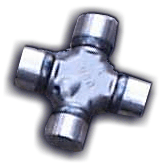 There
are repair kits available for radiator hoses which contain a sleeve
and clamps. You cut the hose at the bad spot, insert the sleeve,
and use the clamps to hold everything in place. A leaky heater hose
can usually be shunted or repaired in a similar fashion by using
a flush and fill fitting in place of the sleeve.
There
are repair kits available for radiator hoses which contain a sleeve
and clamps. You cut the hose at the bad spot, insert the sleeve,
and use the clamps to hold everything in place. A leaky heater hose
can usually be shunted or repaired in a similar fashion by using
a flush and fill fitting in place of the sleeve. 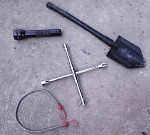 Other
useful items include: 14 gauge wire (better: 12 gauge), solder,
heat shrink tubing, electrical tape, wire connectors, baling wire,
kneadable epoxy, an assortment of grade 8 nuts, bolts and washers,
a variety of cotter pins, a couple of spare lug nuts, a tire repair
kit, a can of radiator stop leak, a cigarette lighter, 5'x7' tarp,
leather gloves, rubber surgical gloves, goggles, a gallon pail,
a turkey baster, ratchet tie-down strap, small 12v air compressor,
fire extinguisher, and garbage bags.
Other
useful items include: 14 gauge wire (better: 12 gauge), solder,
heat shrink tubing, electrical tape, wire connectors, baling wire,
kneadable epoxy, an assortment of grade 8 nuts, bolts and washers,
a variety of cotter pins, a couple of spare lug nuts, a tire repair
kit, a can of radiator stop leak, a cigarette lighter, 5'x7' tarp,
leather gloves, rubber surgical gloves, goggles, a gallon pail,
a turkey baster, ratchet tie-down strap, small 12v air compressor,
fire extinguisher, and garbage bags. 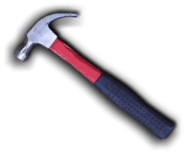 Bring
along enough oil to change your oil on the trail. If your engine
ingests water, you'll have to change the oil and filter. I prefer
to carry a 5 quart container of oil rather than individual bottles.
I usually carry another quart anyway because my Jeep takes 6 quarts
to fill.
Bring
along enough oil to change your oil on the trail. If your engine
ingests water, you'll have to change the oil and filter. I prefer
to carry a 5 quart container of oil rather than individual bottles.
I usually carry another quart anyway because my Jeep takes 6 quarts
to fill. 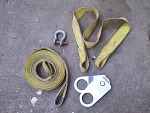 Another
whole article could be written about the gear you need to extricate
yourself from a stuck situation. I carry a shovel, axe, 3"x30'
tow strap, 20' logging chain, tree saver strap, and HiLift jack.
Also, include a clevis to fasten your tree saver to the snatch block.
Another
whole article could be written about the gear you need to extricate
yourself from a stuck situation. I carry a shovel, axe, 3"x30'
tow strap, 20' logging chain, tree saver strap, and HiLift jack.
Also, include a clevis to fasten your tree saver to the snatch block.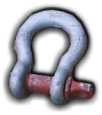 I've
customized my Git Back Box somewhere between Basic Equipment and
Well Equipped. Excluding the extrication gear, you can probably
get basic gear for under $100. But, you don't have to rush out and
buy everything right away. Choose tools that can serve a variety
of purposes to start out, like locking pliers, adjustable wrenches,
and a multipurpose tool. Build your Git Back Box to suit your needs
and your rig. Check with your dealer and parts manufacturers for
specific tools and sizes that fit your rig.
I've
customized my Git Back Box somewhere between Basic Equipment and
Well Equipped. Excluding the extrication gear, you can probably
get basic gear for under $100. But, you don't have to rush out and
buy everything right away. Choose tools that can serve a variety
of purposes to start out, like locking pliers, adjustable wrenches,
and a multipurpose tool. Build your Git Back Box to suit your needs
and your rig. Check with your dealer and parts manufacturers for
specific tools and sizes that fit your rig.